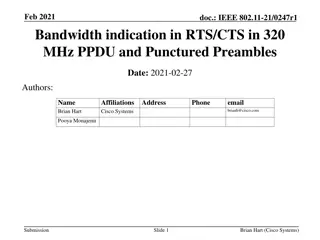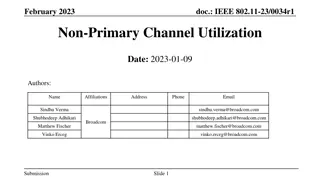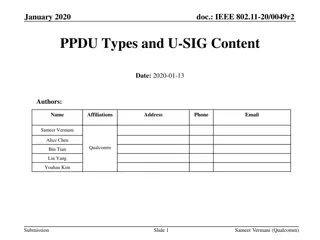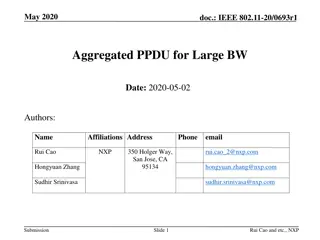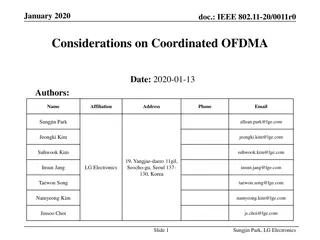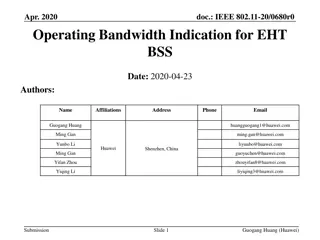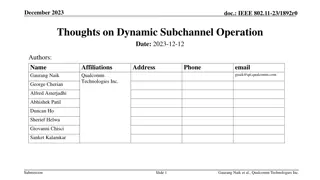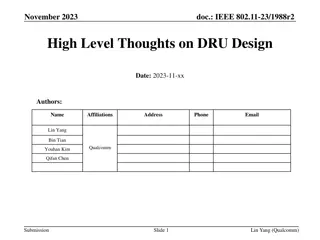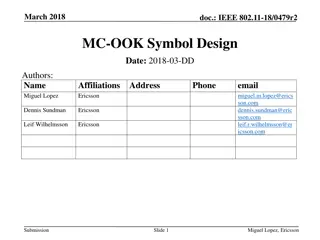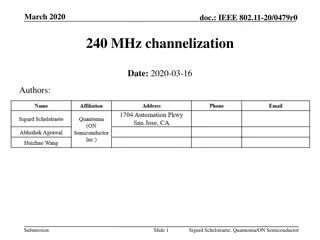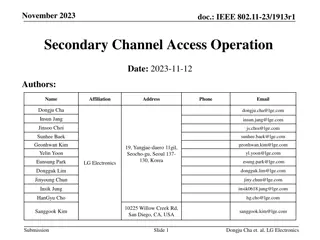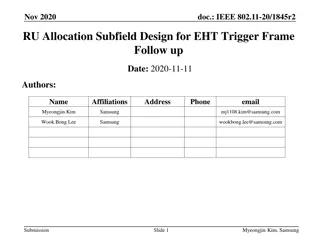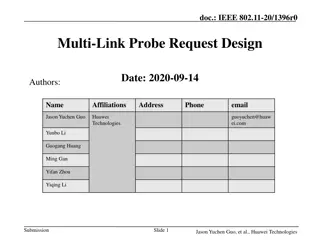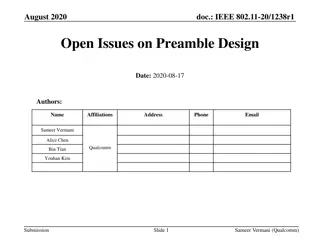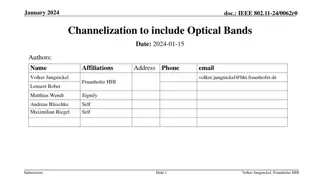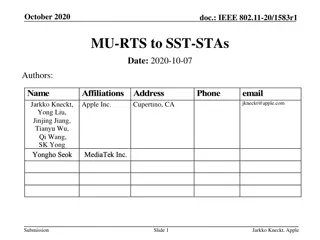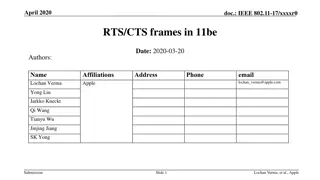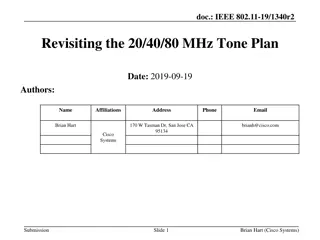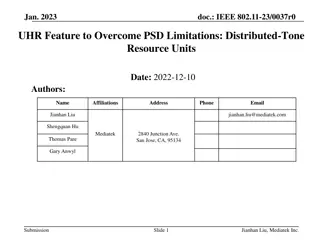Design Considerations for Partial Bandwidth Information in IEEE 802.11-20/1747r1
Design considerations for partial bandwidth information in the IEEE 802.11-20/1747r1 standard are discussed, focusing on EHT NDPA frame structure, feedback mechanisms, bitmap design, and table-based designs to support large RU/MRUs. The feedback mechanism utilizes bitmap resolution signals, providing flexibility in requesting feedback for different subchannels within specified bandwidths. Implementation details for beamformers and beamformees are outlined, emphasizing the need for flexibility in feedback mapping and support for various beamforming modes.
Download Presentation

Please find below an Image/Link to download the presentation.
The content on the website is provided AS IS for your information and personal use only. It may not be sold, licensed, or shared on other websites without obtaining consent from the author. Download presentation by click this link. If you encounter any issues during the download, it is possible that the publisher has removed the file from their server.
E N D
Presentation Transcript
October 2020 doc.: IEEE 802.11-20/1747r1 EHT NDPA Partial BW Info Design Date: 2020-10-30 Authors: Name Affiliations Address Phone email NXP Rui Cao 350 Holger Way, San Jose, CA 95134 rui.cao_2@nxp.com Hari Ram Balakrishnan Sayak Roy Sudhir Srinivasa Submission Slide 1 Rui Cao and etc., NXP
October 2020 doc.: IEEE 802.11-20/1747r1 Introduction It is agreed that EHT NDPA frame reuses the same structure as HE NDPA [1, 2, 3, 4]. STA Info field has 4 bytes. B0 B10 B11 B19 B20 B21 B24 B25 B26 B27 B28 B29 B31 Partial BW Info Feedback Type and Ng Codebook Size AID11 Reserved Nc Disambiguation Reserved Bits 11 9 1 4 2 1 1 3 Partial BW Info field uses 7~9 bits. 11be feedback resolution increases from RU26 to RU242 [5], to reduce complexity and modes. 11be has much better support of channel puncturing. [RU start, RU end] design does not support puncturing cases well. Submission Slide 2 Rui Cao and etc., NXP
October 2020 doc.: IEEE 802.11-20/1747r1 NDPA Partial BW Info Design Table-based designs: proposed [1, 2, 4, 6] ~7 bit table to include all allowed large RU/MRUs A new table needs to be designed. Reuse TB RU table (TBD 9-bit) Only entries corresponds to RU/MRU>=242 are valid. The feedback index parsing is more complex than 11ax. Table entry RU/MRU feedback tone indices Bitmap is a natural way to signal punctured feedback request. [6] bitmap feedback tone indices [6] provides a two-level bitmap design, a little sophisticated. Submission Slide 3 Rui Cao and etc., NXP
October 2020 doc.: IEEE 802.11-20/1747r1 Bitmap Design Partial BW Info using bitmap: 9 bits B0 B1 B8 Resolution Feedback Bitmap 1 bit indicates bitmap resolution: 20MHz or 40MHz Set to 0 for 20MHz for NDP BW<320MHz. Set to 1 for 40MHz for NDP BW=320MHz. Note: 320MHz NDP only allows puncturing granularity of 40MHz. 8-bit bitmap to indicate the request for each resolution size B0=0: 8-bit bitmap signals feedback request for each 20MHz subchannel within 160MHz. B0=1: 8-bit bitmap signals feedback request for each 40MHz subchannel within 320MHz. Submission Slide 4 Rui Cao and etc., NXP
October 2020 doc.: IEEE 802.11-20/1747r1 Partial BW Info Bitmap: examples Partial BW feedback bitmap Feedback RU/MRU 0 0100 0000 1 0100 0000 0 1111 0000 1 1111 0000 0 1111 1101 1 1111 1101 0 1100 1111 1 1100 1111 242 484 996 996*2 996 996*2 484 996 242 484 484 996 996 996*2 Submission Slide 5 Rui Cao and etc., NXP
October 2020 doc.: IEEE 802.11-20/1747r1 Discussions on Bitmap Proposal Simple implementation for both beamformer and beamformee. 8-bit bitmap, no table needed Beamformer: indicate which 20MHz/40MHz to feedback. Beamformee: directly map the bitmap to feedback tone indices. Good flexibility of feedback request Partial BW feedback not necessarily one-to-one mapping with RU/MRU For R1: mainly for supporting OFDMA beamforming, can limit the allowed modes to valid RU/MRU [1,2,4]. For other beamforming overhead reduction usage and R2 MRU extension, more flexibility can be needed. Bitmap based design be easily relaxed to support for the extension. Table based design is limited by the number of Reserved entries. Submission Slide 6 Rui Cao and etc., NXP
October 2020 doc.: IEEE 802.11-20/1747r1 Discussions on Bitmap Proposal (2) 20MHz resolution for 320MHz NDP. [2, 6] The goal is to support 20MHz STAs. No 20MHz-only STA in 6GHz 20MHz-operating STA: may not be interested in partial BW feedback. 320MHz NDP to sound 20MHz STA need to be defined. [7] 320MHz NDP puncturing granularity is 40MHz. 320MHz OFDMA based on 20MHz resolution is also challenging. The proposed bitmap design may be extended to support 20MHz. We don t see the necessity for that. Submission Slide 7 Rui Cao and etc., NXP
October 2020 doc.: IEEE 802.11-20/1747r1 SP Do you agree to use 9-bit to signal NDPA partial BW info field as below? B0 B1 B8 Resolution Feedback Bitmap 1 bit indicates bitmap resolution: 20MHz or 40MHz Set to 0 for 20MHz for NDP BW<320MHz. Set to 1 for 40MHz for NDP BW=320MHz. 8-bit bitmap to indicate the request for each resolution size Submission Slide 8 Rui Cao and etc., NXP
October 2020 doc.: IEEE 802.11-20/1747r1 References [1] Eunsung Jeon and etc., Partial Bandwidth Feedback for Multi- RU , 11-20/950. [2] Chenchen Liu and etc., EHT NDPA Frame Design Discussion , 11-20/1015. [3] Cheng Chen and etc., EHT NDPA frame design , 11-20/1435. [4] Sameer Vermani and etc., NDPA and MIMO Control Field Design for EHT , 11-20/1436. [5] Bin Tian and etc., EHT Punctured NDP and Partial Bandwidth feedback , 11-20/1161 [6] Eunsung Park and etc. Partial BW Info Field Design in NDPA , 11-20/1814. [7] Rui Cao and etc. EHT beamformee NDP and partial BW feedback support , 11-20/1807r0 Submission Slide 9 Rui Cao and etc., NXP
September 2020 doc.: IEEE 802.11-20/1747r1 Appendix Valid RU/MRU Example : 8-bit map: B1B2B3B4B5B6B7B8 If (C0+C1==0 || D0==1 || D1==1), disallowed; // 0000, 1001, 0110, 1010, 0101. elseif (C0+C1=8); elseif (C0+C1=7); elseif (C0+C1=6 && (C0==4 || C1==4)); elseif (C0+C1=5 && (B1B2=00 || B7B8==00)); // (996*2+484): special two-hole cases in 320MHz elseif (C0==0 || C1==0); // RU/MRU <=80MHz: 996, 484+242, 484, 242 else disallowed // No puncture // 20 punctured in 160MHz or 40 punctured in 320MHz // 40 punctured in 160MHz or 80 punctured in 320MHz C0 = (B1+B2+B3+B4), C1= (B5+B6+B7+B8) D0 = ((B1^B2)&(B3^B4)), D1= ((B5^B6)&(B7^B8)) Note: ^ is XOR operation, & is AND operation Submission Slide 10 Rui Cao and etc., NXP



